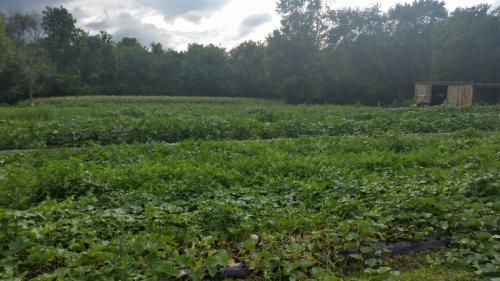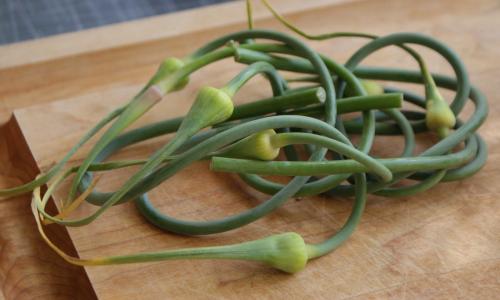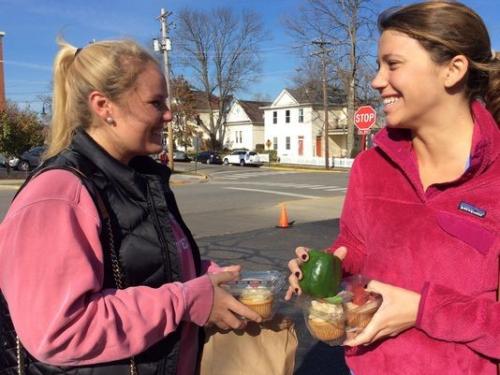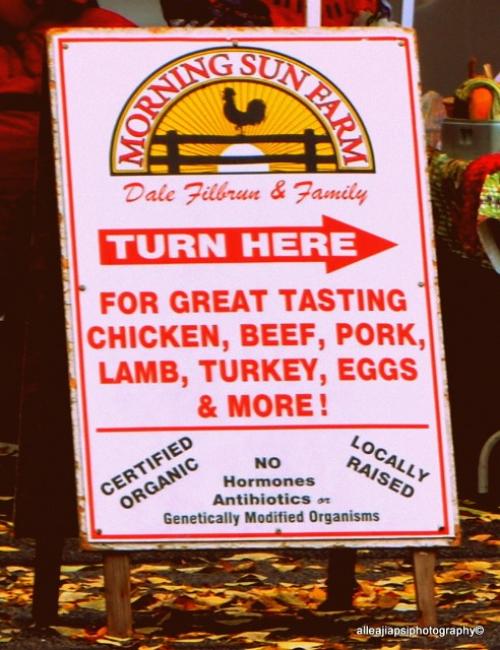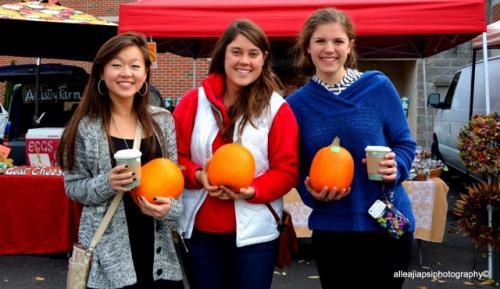Welcome to WordPress. This is your first post. Edit or delete it, then start writing!
Category: Uncategorized (Page 1 of 12)
You can see Brian’s rows of corn in the back of the picture that was taken when we inspected his farm. We inspect all our farms to make sure that our farmers are growing what they bring. We count the rows of corn then estimate how much they will produce. Then watch at market how much corn he brings. Our market council does a lot of work to make sure we maintain a “growers only” market.
This picture of Marley Fraszier enjoying corn grown by Brian Wolford was taken a few weeks ago.
Garlic scapes are the flowering stems of hardneck garlic, which if left uncut will eventually turn into a cluster of small bulbils at the top of the stem. In our region, the scapes emerge from the leaf whorl in early-mid June. The young scapes are a delicious, short-season treat, prized in Asian and European cuisine, and offer a mild garlic flavor useful in many recipes. Favorite dishes include garlic pesto, stir fries, sautes, soups, and salads. Garlic scapes may be frozen for later use, either raw or in a processed form. The season is very short, as the stems become more fibrous quickly, so Oxford Farmer’s Market shoppers will want to take advantage of their availability when they are at their peak in tenderness and flavor.
Jessica Barga posted about an article that was she wrote for the Cincinnati Enquirer: Thank you! Larry Slocum, manager
The local food story I wrote with quotes and photos from the farmer’s market was published in the Cincinnati Enquirer recently – check it out here. A big thanks to all who helped me out!
http://www.cincinnati.com/story/news/2015/01/02/locally-grown-food-fills…
Here is the article:
Locally grown food fills plates at Miami U
By Jessica Barga, Enquirer contributor5:41 p.m. EST January 2, 2015
Students at Miami U have easy access to variety of local products, from fresh honey and fruits to walking sticks and soaps.
Miami students Ashley Mills and Andrea Gevas chat about their purchases at the weekly Oxford Farmers Market.(Photo: Jessica Barga for The Enquirer)Buy Photo
STORY HIGHLIGHTS
• More than one-quarter of products sold in Miami U dining halls are locally bought, officials say.
• Oxford Farmers Market hopes to draw every Miami student ‘at least once,’ manager says.
From made-in-Butler-County honey in every Miami University dining hall to a farmers market in Uptown Oxford each weekend, Miami University students have a growing taste for local food – and the university is catching on.
According to statistics from Miami’s Dining Services, about 26 percent of the products served in campus dining halls are locally purchased.
And the food Miami serves isn’t just local fruits and vegetables – although most of those do come from Butterfield Farms, located just down the road from the campus on Route 73. It also includes ice cream, chocolate and meat, as well as soaps and personal care products.
Part of Miami’s look toward a more sustainable dining program includes the growing availability of local, fresh foods, said Jon Brubacher, director of procurement and food purchasing at Miami.
“Miami likes to support its neighbors and the community,” Brubacher said. “There’s the freshness factor as well – you can have an apple from Washington that was picked weeks ago versus an apple that was growing on a tree nearby just a few days ago.”
But just what does “local food” mean?
Sustainable Table, an organization that teaches about sustainable food and energy practices, described local food as that which is harvested or grown close to where it’s sold, rather than being shipped over long distances. It places a focus on freshness, quality, and giving small, hometown businesses a boost, which can benefit both the grower and the community.
And at Miami, Brubacher said the student response to more local foods has been “overwhelmingly positive.”
Miami is not alone in its commitment to local quality: The surrounding community is a proponent as well, and nowhere is this more evident than at the Oxford Farmers Market.
Located in a Uptown parking lot near La Pinata each Saturday morning, the market hosts local vendors selling fresh honey, alpaca-wool socks, hand-carved walking sticks, and much more.
Buy Photo
Bob Rauen shows off some of his honey, the last of this year’s supply, at the Oxford Farmers Market. Rauen has been making honey for 35 years.(Photo: Jessica Barga for The Enquirer)
Larry Slocum, the market’s manager, said that he has two goals in mind when running the market.
“Number one is that every Miami student comes to visit the market at least once while they’re at school. Because what are they going to do? They’re going to come back and bring their friends,” he said.
“And number two,” he said, “is that every student who leaves Miami and moves away will either support a farmers market there or start their own.”
Slocum, who has been managing the market since 2006, said the benefits of local food are twofold.
“Fresh and local is good for your body, but it’s also great for the community,” he said. “At the market, we’re balancing the community, farmers, and shoppers. It’s like a dance.”
Buy Photo
The Oxford Farmers Market showcases an abundance of fruits and vegetables from local farms and growers.(Photo: Jessica Barga for The Enquirer)
Sarah Pyles, a senior at Miami, is a frequent visitor of the farmers market each week.
“I wake up and I want my breakfast sandwich,” she said, laughing, referring to the homemade focaccia panini she held in her hands.
But the sandwiches aren’t the only draw – Pyles, who lives off-campus, said she looks for goat cheese, veggies, and homemade jams as well.
“I usually shop at Kroger for most of my groceries, but if I’m buying something and see a local option, I’ll go for that one,” she said.
Ashley Mills, another Miami student shopper at the market, said she enjoys visiting because of the unique variety of items.
Buy Photo
Wool socks from fiber raised at Little Patch Alpacas are just one of the many offerings at the Oxford Farmers Market.(Photo: Jessica Barga for The Enquirer)
“Everything’s more fresh than you’d find at some of the regular grocery stores, and there’s a different selection than they have,” said Mills, a senior.
Lara Thurston, who works at the Oxford Coffee Co., said that local business helps keep money in the community and is more sustainable.
The Oxford Coffee Co. is located on Lynn Avenue and has a table at the farmers market each week, Thurston said.
“I think the farmers market is one of the main times people get out each week and see each other,” she said.
Organic turkeys are now available at Morning Sun Farm! Be sure to stop by on Saturday to talk to the folks with Morning Sun Farm about their fresh, certified organic, locally raised, hormone free, antibiotic free, and GMO free meat options for the holiday season! Please click on the Meet Our Vendors tab to read more about Morning Sun Farm including their history and sustainable practices!
Don Pierce of Pierce Street Nursery has taken an interest in growing bok choy in containers that will continue to grow throughout the winter if taken care of properly. This is his first year growing bok choy and is very excited to share his plants with you at the market. You can purchase containers of fully grown bok choy at the Oxford Farmers Market Uptown for less than $7! What’s so awesome about bok choy? It can be eaten all winter long! It will continue to grow like a lettuce if you cut off the outside leaves/stalks as needed. Bok choy loves cold weather so this is a prime food to enjoy this season.
For those of you who are not familiar with bok choy, it is a considered a Chinese cabbage. If you keep reading below, there’s a good amount of information needed to learn the basics of growing, eating, and loving bok choy! And of course, Don will be happy to answer all of the questions you may have when purchasing one of his bok choy plants.
According to online sources, bok choy is a green leafy vegetable used in Chinese and South-east Asian cooking. It has a firm white stem, dark green leaves, and a faintly bitter taste. Since the shape of bok choy’s leaves is like spoon, it is also called “soup spoon”. There are a number of different related varieties, some of which have green stems and lighter-green leaves, which looks like white cabbage, and is also different from Napa cabbage. The bok choy varies in color, taste, and size such as tah tsai and joi choi. Even though bok choy is similar to celery, it is actually a member of the cabbage family (brassica chinensis, or brassica campestris, Chinensis group).
Unlike a western cabbage, the heads are very loose and fan outward instead of close in on themselves. Both the stems and leaves can be used, but the stems take a little longer to cook (though still very little time). Bok choy is used after washing it carefully with the separation of the leaves and the stalks to make sure they are completely clean. It has a mild flavor that permits it to be eaten raw in a salad if the leaves are very small (Baby bok choy), steamed, stir-fried or even deep-fried, braising, boiled and in soups.
Most bok choy varieties are cut-and-come-again plants that allow you to get the maximum harvest from the minimum number of plants. Cut-and-come-again varieties allow you to harvest the outer leaves and stems as you need them and leave the inner parts of the plant to grow. The plant will continue to produce new leaves over a long period of time.
Bok choy can be fresh in the refrigerator for up to six days without washing. So, only wash it as needed. The veggie is filled with vitamins A and C. One cup of cooked bok choy offers more than 100% of the recommended dietary allowance of A, and close to two-thirds of the RDA of C.
Bok choy can grow in the same type of containers that traditionally serve as homes for houseplants, but it needs a much larger pot than the average ornamental. Bok choy grows fast and needs lots of water, so the pot has to contain a large volume of soil that can hold an adequate amount of moisture. A traditional container that is 1 foot wide and 20 inches deep holds an adequate volume of soil for one bok choy plant. Self-watering containers hold water in a reservoir beneath the pot, allowing you to grow thirsty plants in a much smaller volume of soil. Bok choy roots are compact and grow close to the surface of the soil, allowing you to grow one plant in a self-watering container half of the recommended size of a traditional container, or four plants in 2-foot diameter pot. Self watering pots allow you to water your plants without getting the foliage wet, which puts them at risk for disease.
Mindy Kong, Shannon Hogan, and Margaret Clark are happy market shoppers! What’s a better way to spend Saturday morning than with your girls at the local farmers market? Smiles are abundant at the Oxford Farmers Market…. you are guaranteed to go home with one! And maybe a pumpkin or two or three… and some mums…. oh and some fresh produce…. oh can’t forget the artisan bread!
Mindy, Shannon, and Margaret are students at Miami.
You will always find little Ezio having fun. His bright smile and cheerful nature brings nothing but elation to the market! Ezio is the son of Anne Roma and Per Boland.

